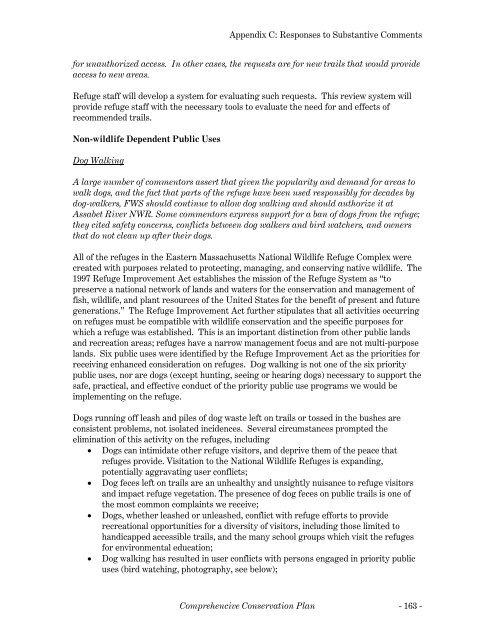Assabet River NWR Final CCP - U.S. Fish and Wildlife Service
Assabet River NWR Final CCP - U.S. Fish and Wildlife Service
Assabet River NWR Final CCP - U.S. Fish and Wildlife Service
Create successful ePaper yourself
Turn your PDF publications into a flip-book with our unique Google optimized e-Paper software.
Appendix C: Responses to Substantive Comments<br />
for unauthorized access. In other cases, the requests are for new trails that would provide<br />
access to new areas.<br />
Refuge staff will develop a system for evaluating such requests. This review system will<br />
provide refuge staff with the necessary tools to evaluate the need for <strong>and</strong> effects of<br />
recommended trails.<br />
Non-wildlife Dependent Public Uses<br />
Dog Walking<br />
A large number of commentors assert that given the popularity <strong>and</strong> dem<strong>and</strong> for areas to<br />
walk dogs, <strong>and</strong> the fact that parts of the refuge have been used responsibly for decades by<br />
dog-walkers, FWS should continue to allow dog walking <strong>and</strong> should authorize it at<br />
<strong>Assabet</strong> <strong>River</strong> <strong>NWR</strong>. Some commentors express support for a ban of dogs from the refuge;<br />
they cited safety concerns, conflicts between dog walkers <strong>and</strong> bird watchers, <strong>and</strong> owners<br />
that do not clean up after their dogs.<br />
All of the refuges in the Eastern Massachusetts National <strong>Wildlife</strong> Refuge Complex were<br />
created with purposes related to protecting, managing, <strong>and</strong> conserving native wildlife. The<br />
1997 Refuge Improvement Act establishes the mission of the Refuge System as “to<br />
preserve a national network of l<strong>and</strong>s <strong>and</strong> waters for the conservation <strong>and</strong> management of<br />
fish, wildlife, <strong>and</strong> plant resources of the United States for the benefit of present <strong>and</strong> future<br />
generations.” The Refuge Improvement Act further stipulates that all activities occurring<br />
on refuges must be compatible with wildlife conservation <strong>and</strong> the specific purposes for<br />
which a refuge was established. This is an important distinction from other public l<strong>and</strong>s<br />
<strong>and</strong> recreation areas; refuges have a narrow management focus <strong>and</strong> are not multi-purpose<br />
l<strong>and</strong>s. Six public uses were identified by the Refuge Improvement Act as the priorities for<br />
receiving enhanced consideration on refuges. Dog walking is not one of the six priority<br />
public uses, nor are dogs (except hunting, seeing or hearing dogs) necessary to support the<br />
safe, practical, <strong>and</strong> effective conduct of the priority public use programs we would be<br />
implementing on the refuge.<br />
Dogs running off leash <strong>and</strong> piles of dog waste left on trails or tossed in the bushes are<br />
consistent problems, not isolated incidences. Several circumstances prompted the<br />
elimination of this activity on the refuges, including<br />
• Dogs can intimidate other refuge visitors, <strong>and</strong> deprive them of the peace that<br />
refuges provide. Visitation to the National <strong>Wildlife</strong> Refuges is exp<strong>and</strong>ing,<br />
potentially aggravating user conflicts;<br />
• Dog feces left on trails are an unhealthy <strong>and</strong> unsightly nuisance to refuge visitors<br />
<strong>and</strong> impact refuge vegetation. The presence of dog feces on public trails is one of<br />
the most common complaints we receive;<br />
• Dogs, whether leashed or unleashed, conflict with refuge efforts to provide<br />
recreational opportunities for a diversity of visitors, including those limited to<br />
h<strong>and</strong>icapped accessible trails, <strong>and</strong> the many school groups which visit the refuges<br />
for environmental education;<br />
• Dog walking has resulted in user conflicts with persons engaged in priority public<br />
uses (bird watching, photography, see below);<br />
Comprehencive Conservation Plan - 163 -

















